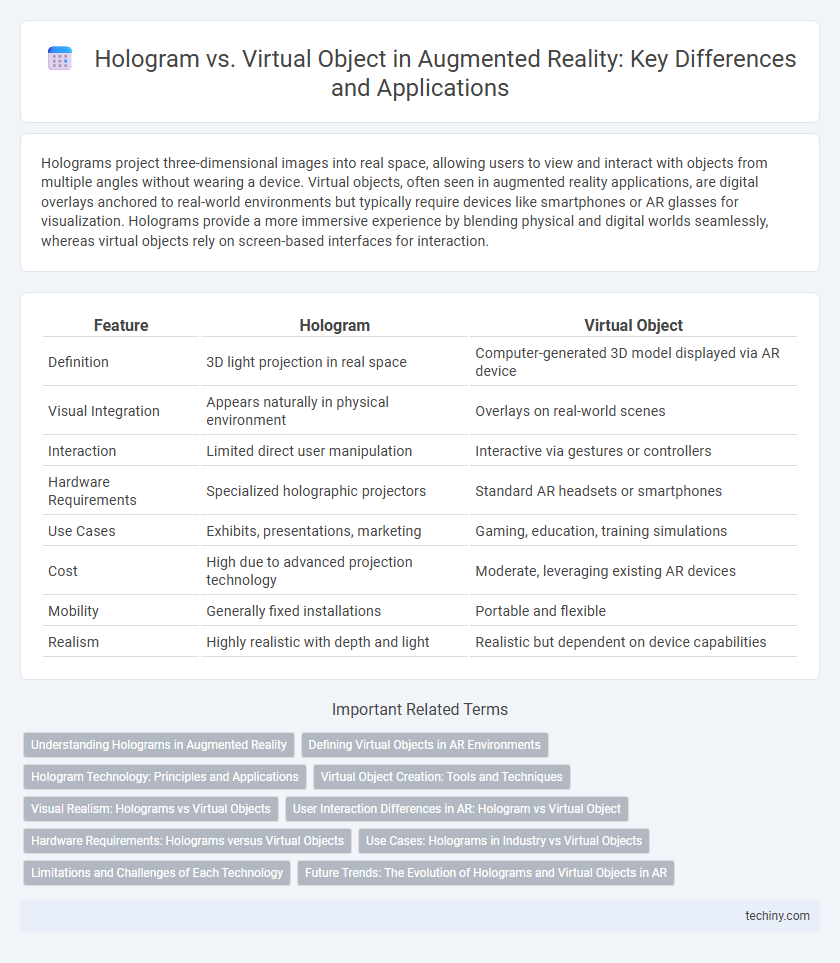Holograms project three-dimensional images into real space, allowing users to view and interact with objects from multiple angles without wearing a device. Virtual objects, often seen in augmented reality applications, are digital overlays anchored to real-world environments but typically require devices like smartphones or AR glasses for visualization. Holograms provide a more immersive experience by blending physical and digital worlds seamlessly, whereas virtual objects rely on screen-based interfaces for interaction.
Table of Comparison
| Feature | Hologram | Virtual Object |
|---|---|---|
| Definition | 3D light projection in real space | Computer-generated 3D model displayed via AR device |
| Visual Integration | Appears naturally in physical environment | Overlays on real-world scenes |
| Interaction | Limited direct user manipulation | Interactive via gestures or controllers |
| Hardware Requirements | Specialized holographic projectors | Standard AR headsets or smartphones |
| Use Cases | Exhibits, presentations, marketing | Gaming, education, training simulations |
| Cost | High due to advanced projection technology | Moderate, leveraging existing AR devices |
| Mobility | Generally fixed installations | Portable and flexible |
| Realism | Highly realistic with depth and light | Realistic but dependent on device capabilities |
Understanding Holograms in Augmented Reality
Holograms in augmented reality are three-dimensional light projections that interact with real-world environments, offering a more immersive experience than traditional virtual objects, which are flat, screen-based images. Unlike virtual objects confined to digital displays, holograms maintain spatial awareness, enabling users to view and manipulate them from multiple angles. This spatial coherence makes holograms essential for applications in training, design, and remote collaboration within augmented reality platforms.
Defining Virtual Objects in AR Environments
Virtual objects in augmented reality environments are digitally created entities that seamlessly blend with the real world, enhancing user interaction by providing contextual information or entertainment. Unlike holograms, which are fully three-dimensional projections visible without specialized devices, virtual objects require AR hardware such as headsets or smartphones to be viewed and manipulated within the physical space. These objects can range from simple 3D models to complex interactive elements that respond to user actions and environmental cues, central to creating immersive AR experiences.
Hologram Technology: Principles and Applications
Hologram technology utilizes the interference patterns of light waves to create three-dimensional images that appear to float in space, enabling realistic visualization without the need for headsets. Unlike virtual objects in augmented reality that rely on digital rendering and screen overlays, holograms offer true depth perception and parallax effects by reconstructing light fields. Applications of hologram technology span medical imaging, architectural visualization, and interactive displays, enhancing user engagement through immersive and tangible experiences.
Virtual Object Creation: Tools and Techniques
Virtual object creation in augmented reality relies on advanced tools such as 3D modeling software like Blender, Autodesk Maya, and Unity 3D to design detailed and interactive objects. Techniques include photogrammetry for realistic texture mapping and procedural generation to automate complex environments, enhancing immersion. Integrating these virtual objects seamlessly into real-world environments requires precise spatial mapping and sensor data calibration to maintain accurate positioning and user interaction.
Visual Realism: Holograms vs Virtual Objects
Holograms provide superior visual realism by projecting three-dimensional images that appear naturally integrated within the physical environment, enabling realistic depth perception and parallax effects. Virtual objects, while often highly detailed and interactive, are typically rendered on flat screens or through headsets, limiting their spatial presence and depth cues. The key distinction lies in holograms' ability to simulate light fields accurately, creating a more immersive and convincing visual experience compared to conventional virtual objects.
User Interaction Differences in AR: Hologram vs Virtual Object
User interaction with holograms in augmented reality involves perceiving and manipulating three-dimensional projections within the real environment, enabling gestures and spatial awareness for more intuitive control. Virtual objects, however, are often anchored to surfaces or fixed points in the AR space, requiring touch or device-based inputs for interaction. The key distinction lies in holograms offering more fluid, gesture-based engagement, while virtual objects rely on more traditional input methods within the AR interface.
Hardware Requirements: Holograms versus Virtual Objects
Holograms demand advanced projection hardware such as laser-based displays and light field projectors to create true 3D images visible from multiple angles, requiring intricate optical systems and high processing power. Virtual objects in augmented reality rely primarily on standard AR headsets or smartphones equipped with cameras, sensors, and powerful GPUs to render 3D models within real-world environments. The significant difference in hardware complexity impacts device cost, portability, and user experience quality between hologram-based and traditional AR virtual object systems.
Use Cases: Holograms in Industry vs Virtual Objects
Holograms in industry enable precise 3D visualization for design reviews and remote collaboration, enhancing manufacturing workflows and maintenance training. Virtual objects, often integrated into AR applications, facilitate interactive product demonstrations and real-time data overlays for on-site decision-making in sectors like retail and logistics. Both technologies improve operational efficiency, but holograms provide a more immersive spatial presence, while virtual objects offer greater flexibility in scalable AR environments.
Limitations and Challenges of Each Technology
Holograms often face limitations such as high production costs and the need for specialized display equipment, restricting accessibility and scalability. Virtual objects, while more easily integrated into mobile AR applications, grapple with challenges in achieving realistic depth perception and seamless interaction within real-world environments. Both technologies must overcome issues related to occlusion, lighting consistency, and user experience to advance practical AR implementations.
Future Trends: The Evolution of Holograms and Virtual Objects in AR
Holograms in augmented reality are evolving towards higher resolution and more realistic 3D projections, enabling seamless integration with physical environments. Virtual objects are becoming increasingly interactive and context-aware through AI-driven enhancements, allowing personalized user experiences. Future trends indicate a convergence of holographic displays and virtual object manipulation, fostering immersive, mixed reality applications across industries like education, healthcare, and entertainment.
hologram vs virtual object Infographic

 techiny.com
techiny.com